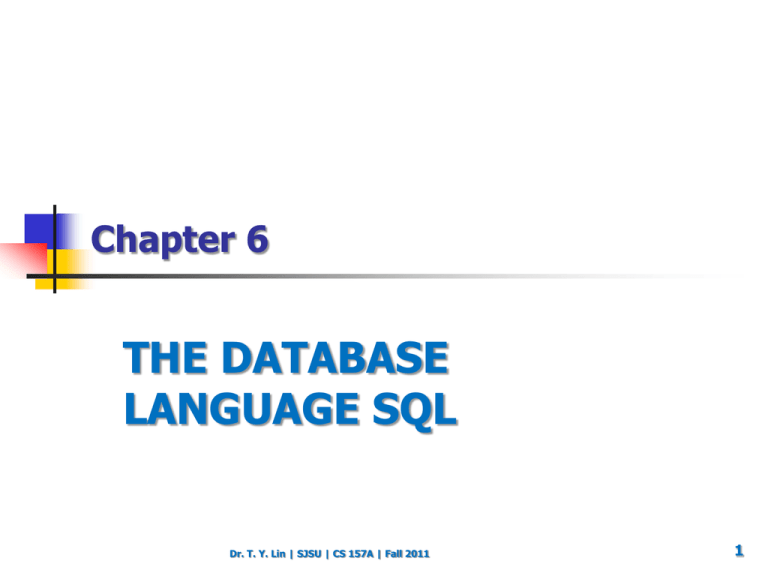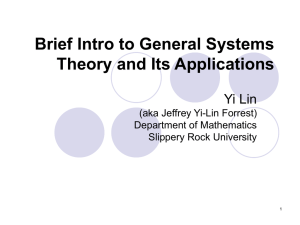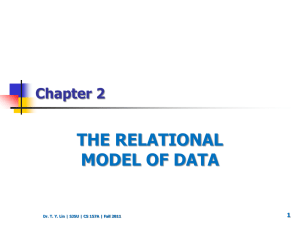CS 157A Chap 6 - Ahmad4 - Department of Computer Science
advertisement

Chapter 6
THE DATABASE
LANGUAGE SQL
Dr. T. Y. Lin | SJSU | CS 157A | Fall 2011
1
6. The Database Language SQL
6.1 . 4
6.1.7.
Dr. T. Y. Lin | SJSU | CS 157A | Fall 2011
2
6. The Database Language SQL
6.1 Simple Queries in SQL
6.2 Queries Involving More Than One Relation
6.3 Subqueries
6.4 Full-Relation Operation
6.5 Database Modification
6.6 Transactions in SQL
6.7 Summary of Chapter 6
6.8 References for chapter 6
Dr. T. Y. Lin | SJSU | CS 157A | Fall 2011
3
Introduction
SQL (pronounce “sequel”) stands for:
Structured Query Language
SQL consists of:
DML (Data Manipulation Language)
DDL (Data Definition Language)
Dialects of SQL:
ANSI SQL
SQL-92 or SQL2
SQL-99 or SQL3
SQL:2003
Dr. T. Y. Lin | SJSU | CS 157A | Fall 2011
4
Introduction (cont’d)
There are versions of SQL produced by the
principal DBMS vendors.
They support ANSI standards
Conform to a large extent to the more recent SQL2
Each has its variations and extensions beyond SQL2
including some of the features in the SQL-99 and
SQL:2003
Dr. T. Y. Lin | SJSU | CS 157A | Fall 2011
5
Section 6.1
SIMPLE QUERIES IN SQL
Dr. T. Y. Lin | SJSU | CS 157A | Fall 2011
6
6.1 Simple Queries in SQL
6.1.1 Projecting in SQL
6.1.2 Selecting in SQL
6.1.3 Comparison of Strings
6.1.4 Pattern Matching in SQL
6.1.5 Dates and Times
6.1.6 Null Values and Comparisons Involving
NULL
6.1.7 The Truth-Value UNKNOWN
6.1.8 Ordering the Output
6.1.9 Exercises for Section 6.1
Dr. T. Y. Lin | SJSU | CS 157A | Fall 2011
7
6.1 Simple Queries in SQL
A simple query uses the following keywords:
SELECT , FROM, WHERE (BNF)
We call these queries: select-from-where form
Dr. T. Y. Lin | SJSU | CS 157A | Fall 2011
8
6.1 Simple Queries in SQL (cont’d)
Example 6.1 (selection)
Given the relation Movies with the following
schema:
Movies(title, year, length, genre,
studioName, producerC#)
Query all movies produced by Disney Studios
in 1990
SELECT *
FROM
Movies
WHERE studioName = ‘Disney’
AND
year = 1990;
Dr. T. Y. Lin | SJSU | CS 157A | Fall 2011
9
6.1.1 Projection in SQL
We can project the relation produced by a SQL
onto some of its attributes.
Example 6.2
Modify the example 6.1 and bring just title
and length of the movies with the same
condition.
SELECT title, length
FROM
Movies
WHERE studioName = 'DISNEY'
AND
year = 1990;
Dr. T. Y. Lin | SJSU | CS 157A | Fall 2011
10
6.1.1 Projection in SQL (cont’d)
If you wish to have different names for the
attributes, then just type what you wish as
follows:
Example 6.3
SELECT
FROM
WHERE
AND
title AS name, length AS duration
Movies
studioName = 'DISNEY'
year = 1990;
Note that you can eliminate “AS”
Dr. T. Y. Lin | SJSU | CS 157A | Fall 2011
11
6.1.1 Projection in SQL (cont’d)
Another option is to use an expression in place
of an attribute.
Example 6.4
compute the length in hours
SELECT title AS name,
length/60 AS Length_In_Hours
FROM
Movies
WHERE studioName = 'DISNEY'
AND
year = 1990;
Dr. T. Y. Lin | SJSU | CS 157A | Fall 2011
12
6.1.1 Projection in SQL (cont’d)
Another option is to use a constant in place of
an attribute.
Example 6.5
SELECT title,
length/60 AS Length
‘hrs.’ AS Hours
FROM
Movies
WHERE studioName = 'DISNEY'
AND
year = 1990;
Note that SQL is case insensitive.
Dr. T. Y. Lin | SJSU | CS 157A | Fall 2011
13
6.1.2 Selection in SQL
We can select desired tuples through “WHERE”
clause.
Comparison operators:
= (like == in Java)
<> (like != in Java)
<
>
<=
>=
Concatenation operator for strings: ||
Dr. T. Y. Lin | SJSU | CS 157A | Fall 2011
14
6.1.2 Selection in SQL (cont’d)
String constants are surrounded by single
quotes. Like ‘Disney’ in the previous
examples.
Numeric constants can be Integer or Real.
The result of a comparison is TRUE or FALSE.
Logical operators are: AND, OR, NOT
The precedence of logical operators is:
NOT, AND, OR
Use parenthesis to break this precedence.
Dr. T. Y. Lin | SJSU | CS 157A | Fall 2011
15
6.1.2 Selection in SQL (cont’d)
Example 6.6
Query for the movies that made by ‘MGM’
studios and either were made after 1970 or
were less than 90 minutes long.
SELECT
FROM
WHERE
AND
title
Movies
studioName = ‘MGM’
(year > 1970 OR length < 90);
Dr. T. Y. Lin | SJSU | CS 157A | Fall 2011
16
6.1.2 Selection in SQL (cont’d)
Example 6.6
Query for the movies that made by ‘MGM’
studios and either were made after 1970 or
were less than 90 minutes long.
SELECT
FROM
WHERE
AND
title
Movies
studioName = ‘MGM’
(year > 1970 OR length < 90);
Dr. T. Y. Lin | SJSU | CS 157A | Fall 2011
17
6.1.3 Comparison of Strings
Strings can be stored as either fixed-length
using CHAR data type or variable-length using
VARCHAR.
When comparing strings, only real characters
are considered and padding characters are
ignored regardless of the data type
declaration.
When comparing strings using <, >, <=, or
>=, lexicographic order of characters are
considered. (like dictionary)
Dr. T. Y. Lin | SJSU | CS 157A | Fall 2011
18
6.1.3 Comparison of Strings
(cont’d)
Example:
‘fodder’ < ‘foo’
Because, ‘fo’ = ‘fo’ but ‘d’ < ‘o’
Example:
‘bar’ < ‘bargain’
Because, ‘bar’ = ‘bar’ but ‘’ < ‘gain’
Note that ‘A’ < ‘a’
Dr. T. Y. Lin | SJSU | CS 157A | Fall 2011
19
6.1.4 Pattern Matching in SQL
Two alternative forms of comparison are:
s LIKE p
s NOT LIKE p
Where s is a string and p is a pattern.
p can contain wildcards or ordinary chars.
% matches zero or more chars
_ (underscore) matches one char
Note that strings are case sensitive.
Dr. T. Y. Lin | SJSU | CS 157A | Fall 2011
20
6.1.4 Pattern Matching in SQL
(cont’d)
Example 6.7
SELECT title
FROM
Movies
WHERE title LIKE 'STAR_ _ _ _ _';
SELECT title FROM Movies WHERE title LIKE 'STAR ____';
Retrieves the titles that starts with ‘STAR’, then one
blank and the 4 last chars can be anything.
So, possible matches can be:
‘Star Wars’, ‘Star Trek’
Dr. T. Y. Lin | SJSU | CS 157A | Fall 2011
21
6.1.4 Pattern Matching in SQL
(cont’d)
Example 6.8
SELECT title
FROM
Movies
WHERE title LIKE ‘%’’s%’;
Note that if your string contains single quote,
put another single quote to distinguish
between surrounding single quotes and the
single quote itself.
Retrieve all movies that contain the ‘s in their
name like: Logan’s Run, Alice’s Restaurant
Dr. T. Y. Lin | SJSU | CS 157A | Fall 2011
22
6.1.5 Dates and Times
A date constant is represented by the keyword
DATE followed by a quoted string.
For example: DATE ‘1961-08-24’
Note the strict format of the ‘YYYY-mm-dd’
Dr. T. Y. Lin | SJSU | CS 157A | Fall 2011
23
6.1.5 Dates and Times (cont’d)
A time constant is represented by the keyword
TIME followed by a quoted string.
For example: TIME ’15:05:03’
Another example: TIME ’15:05:03.15’
Note the strict format of ‘HH:mm:ss’
and ‘HH:mm:ss.nnn’
Note that HH is a military format (24-hour)
Fractions of seconds can be as many as
significant digit you like
Dr. T. Y. Lin | SJSU | CS 157A | Fall 2011
24
6.1.5 Dates and Times (cont’d)
An alternative for the time is to represent it
with respect to GMT (Greenwich Mean Time)
TIME ‘HH:mm:ss – HH:mm’ to represent the
times behind GMT.
For example: TIME ‘12:00:00 – 8:00) represent
the noon in Pacific standard time (PST)
TIME ‘HH:mm:ss + HH:mm’ to represent the
times ahead GMT.
Dr. T. Y. Lin | SJSU | CS 157A | Fall 2011
25
6.1.5 Dates and Times (cont’d)
To combine date and time, we use a value of
type TIMESTAMP.
Use format:
TIMESTAMP ‘YYYY-mm-dd HH:mm:ss’
to represent a timestamp.
Note the space between the date and the time.
For example:
TIMESTAMP ‘1961-08-24 12:00:00’
TIMESTAMPs values can be compared by the
comparison operators.
Dr. T. Y. Lin | SJSU | CS 157A | Fall 2011
26
6.1.6 Null Values and Comparisons
Involving NULL
Different interpretations for NULL values:
1. Value unknown
I know there is some value here but I don’t
know what it is?
2. Value inapplicable
There is no value that make sense here.
3. Value withheld
We are not entitled to know this value.
Dr. T. Y. Lin | SJSU | CS 157A | Fall 2011
27
6.1.6 Null Values and Comparisons
Involving NULL (cont’d)
When operating upon a NULL value, remember
that:
1. The result would be NULL if any value,
including NULL, is one of the operands of an
arithmetic operation.
Example: price + 1 = NULL if the price is
NULL
2. The result would be UNKNOWN if we compare
a value, including NULL, with NULL.
Example: ‘Ali’ < NULL is UNKNOWN
Note that NULL is not a constant.
Dr. T. Y. Lin | SJSU | CS 157A | Fall 2011
28
6.1.6 Null Values and Comparisons
Involving NULL (cont’d)
Example 6.9
Let x have the value NULL
Then x + 3 is also NULL
But NULL + 3 is not a legal SQL expression
Also: x=3 is unknown in the above example
because we cannot say whether the x which
currently is NULL is equal 3 or not?
Note that NULL = 3 is not correct SQL.
We use: x IS NULL or x IS NOT NULL to check
if the x is NULL or not.
Dr. T. Y. Lin | SJSU | CS 157A | Fall 2011
29
6.1.7 The Truth-Value UNKNOWN
UNKNOWN is the third truth value beside TRUE
and FALSE.
To memorize what the results of an operation
would be, consider TRUE = 1, FALSE = 0, and
UNKNOWN = ½
The AND of two operand is the minimum of
those values
The OR of two operand is the maximum of
those values
The NOT of a value v is 1 - v
Dr. T. Y. Lin | SJSU | CS 157A | Fall 2011
30
6.1.7 The Truth-Value UNKNOWN
(cont’d)
The truth table
X
Y
X AND Y
X OR Y
NOT X
TRUE
TRUE
TRUE
TRUE
FALSE
TRUE
UNKNOWN
UNKNOWN
TRUE
FALSE
TRUE
FALSE
FALSE
TRUE
FALSE
UNKNOWN
TRUE
UNKNOWN
TRUE
UNKNOWN
UNKNOWN
UNKNOWN
UNKNOWN
UNKNOWN
UNKNOWN
UNKNOWN
FALSE
FALSE
UNKNOWN
UNKNOWN
FALSE
TRUE
FALSE
TRUE
TRUE
FALSE
UNKNOWN
FALSE
UNKNOWN
TRUE
FALSE
FALSE
FALSE
FALSE
TRUE
Dr. T. Y. Lin | SJSU | CS 157A | Fall 2011
31
6.1.7 The Truth-Value UNKNOWN
(cont’d)
The relevant tuples won’t be retrieved if a
condition in WHERE clause is evaluated to
UNKNOWN.
Example 6.10
SELECT *
FROM
Movies_null
WHERE length <= 120 OR length > 120;
The query won’t retrieve the tuples that
contain NULL values in the length column even
though we expect it should bring all movies.
Dr. T. Y. Lin | SJSU | CS 157A | Fall 2011
32
6.1.7 The Truth-Value UNKNOWN
(cont’d)
The relevant tuples won’t be retrieved if a
condition in WHERE clause is evaluated to
UNKNOWN.
Example 6.10
SELECT Studioname
FROM
Movies_null
WHERE length is null;
Dr. T. Y. Lin | SJSU | CS 157A | Fall 2011
33
6.1.8 Ordering the Output
We may ask to represent the output in sorted
order.
We modify the select-from-where format and
add the following clause:
ORDER BY <list of attributes>
The order is by default ascending but you can
ask to order in descending order by appending
the keyword DESC to an attributes
Similarly, you can add keyword ASC for
ascending order.
Dr. T. Y. Lin | SJSU | CS 157A | Fall 2011
34
6.1.8 Ordering the Output (cont’d)
Example 6.11
SELECT producerC#,title
FROM
Movies
WHERE studioName = 'DISNEY'
AND
year = 1990
ORDER BY length DESC, title;
Note that we can list any attributes in the
ORDER BY clause even if the attributes are not
listed in the SELECT clause.
The list can even have an expression. For
example ORDER BY year - 10
Dr. T. Y. Lin | SJSU | CS 157A | Fall 2011
35
6.1.9 Exercises for Section 6.1
Dr. T. Y. Lin | SJSU | CS 157A | Fall 2011
36
Section 6.2
QUERIES INVOLVING MORE THAN
ONE RELATION
Dr. T. Y. Lin | SJSU | CS 157A | Fall 2011
37
6.2 Queries Involving More Than
One Relation
6.2.1 Products and Joins in SQL
6.2.2 Disambiguating Attributes
6.2.3 Tuple Variables
6.2.4 Interpreting Multi-Relation Queries
6.2.5 Union, Intersection, and Difference of
Queries
6.2.6 Exercises for Section 6.2
Dr. T. Y. Lin | SJSU | CS 157A | Fall 2011
38
6.2.1 Products and Joins in SQL
Cartesian product of two relations R(a, b)
containing n tuples and T(c, d, e) containing m
tuples, produces another relation
U(a, b, c, d, e) with n x m tuples.
To have a clear picture about what happens
when we make a Cartesian product of two
relations, consider a two level nested for-loop:
in the outer loop, each tuples of R is retrieved
and in the inner loop, it combines with each
tuples of T and produce the resulting relation
tuples.
Dr. T. Y. Lin | SJSU | CS 157A | Fall 2011
39
6.2.1 Products and Joins in SQL
(Product)
Example 6.12a
Movies(title, year, length, genre,
studioName, producerC#)
MovieExec(name, address, cert#, netWorth)
SELECT *
FROM
Movies, MovieExec
Dr. T. Y. Lin | SJSU | CS 157A | Fall 2011
40
6.2.1 Products and Joins in SQL
(cont’d)
Cartesian product of two relations are not
usually used. We should eliminate the
unnecessary tuples by applying some
conditions in the WHERE clause.
Based on what conditions we apply in the
WHERE clause, different types of joins are
produced.
Dr. T. Y. Lin | SJSU | CS 157A | Fall 2011
41
6.2.1 Products and Joins in SQL
(Equi/Theta Join)
Example 6.12a
Retrieve the name of the producer of ‘Star Wars’.
We need the following relations:
Movies(title, year, length, Incolor,
studioName, producerC#)
MovieExec(name, address, cert#, netWorth)
SELECT
FROM
WHERE
AND
*
Movies, MovieExec
title = 'STAR WARS'
producerC# = cert#;
Dr. T. Y. Lin | SJSU | CS 157A | Fall 2011
42
6.2.1 Products and Joins in SQL
(DB1)
EquiJoin
EquiJoin involves the join of two or more
tables using the equality operator. The
equijoin by definition produces a result
containing two identical columns.
Dr. T. Y. Lin | SJSU | CS 157A | Fall 2011
43
6.2.1 Products and Joins in SQL
(DB1)
Example :
Get all supplier and part information such that
the supplier and part in question are located in
the same city.
SELECT
FROM
WHERE
SUPPLIER.*, PART.*
SUPPLIER, PART
SUPPLIER.CITY=PART.CITY;
Dr. T. Y. Lin | SJSU | CS 157A | Fall 2011
44
6.2.1 Products and Joins in SQL
(Natural Join)
Example 6.12b
SELECT
title, year, length, InColor, studioName,
producerC#,name,address,cert#(del),netWorth
FROM
WHERE
AND
Movies, MovieExec
title = 'STAR WARS'
producerC# = cert#;
Dr. T. Y. Lin | SJSU | CS 157A | Fall 2011
45
6.2.1 Products and Joins in SQL
(cont’d)
Example 6.12
Retrieve the name of the producer of ‘Star Wars’.
We need the following relations:
Movies(title, year, length, InColor,
studioName, producerC#)
MovieExec(name, address, cert#, netWorth)
SELECT
FROM
WHERE
AND
name
Movies, MovieExec
title = 'STAR WARS'
producerC# = cert#;
Dr. T. Y. Lin | SJSU | CS 157A | Fall 2011
46
6.2.1 Products and Joins in SQL
(DB1)
Natural Join
In the equijoin, if one of the two identical
columns is eliminated, then what is left is
called the natural join. Natural join is probably
the single most useful form of join and is
usually referred to as simply "Join"
Dr. T. Y. Lin | SJSU | CS 157A | Fall 2011
47
6.2.1 Products and Joins in SQL
(DB1)
SELECT
S.SNUM, S.SNAME, S.STATUS,
S.CITY, P.PNUM, P.PNAME, P.COLOR, P.WEIGHT
FROM
SUPPLIERS S, PARTS P
Where S.CITY=P.CITY;
Dr. T. Y. Lin | SJSU | CS 157A | Fall 2011
48
6.2.2 Disambiguating Attributes
If the relations involving in a join contain
attributes with the same name, then we must
qualify each attribute by the relation name and
a dot as follows:
Example 6.13
Retrieve pairs of stars and executives with the
same address.
SELECT MovieStar.name, MovieExec.name
FROM
MovieStar, MovieExec
WHERE MovieStar.address =
MovieExec.address;
Dr. T. Y. Lin | SJSU | CS 157A | Fall 2011
49
6.2.3 Tuple Variables
Sometimes we need to join a relation with
itself. So, the previous method does not work
here.
We may list a relation R as many times as we
need to in the FROM clause.
We need a way to refer to each occurrence of
R.
SQL allows us to define an alias for each
occurrence of R.
This is also called Tuple Variable.
Dr. T. Y. Lin | SJSU | CS 157A | Fall 2011
50
6.2.3 Tuple Variables (cont’d)
Tuple variable syntax:
From R AS R1, R AS R2, ...
Note that AS is optional and usually we omit it.
If a relation has an alias, you are allowed to
disambiguate the attributes with the alias as
well.
When you don’t mention tuple variable for a
relation, in fact it has a tuple variable with the
same name of the relation.
Dr. T. Y. Lin | SJSU | CS 157A | Fall 2011
51
6.2.3 Tuple Variables (cont’d)
Example 6.14
Retrieve pairs of stars that share the same
address.
SELECT Star1.name, Star2.name
FROM MovieStar Star1, MovieStar Star2
WHERE Star1.address = Star2.address
AND
Star1.name < Star2.name;
What’s the role of the second condition?
What would happen if we use <>?
Dr. T. Y. Lin | SJSU | CS 157A | Fall 2011
52
6.2.4 Interpreting Multi-Relation
Queries
If there are several tuple variables, we may
imagine nested loops, one for each tuple
variable, in which the variables each range
over the tuples of their respective relations.
For each assignment of tuples to the tuple
variables, we decide whether the WHERE
clause is true.
If so, we produce a tuple consisting of the
values of the expressions following SELECT.
Dr. T. Y. Lin | SJSU | CS 157A | Fall 2011
53
6.2.4 Interpreting Multi-Relation
Queries (cont’d)
Another approach is to relate the query to
relational algebra.
At first, create the Cartesian product of the
relations.
Then, apply selection operator by considering
WHERE clause conditions.
Then, make a projection of the attributes listed
in the SELECT clause.
Dr. T. Y. Lin | SJSU | CS 157A | Fall 2011
54
6.2.4 Interpreting Multi-Relation
Queries (cont’d)
Example 6.15
Convert the query of example 6.14 to RA.
ΠL1 (σC1 And C2 (R X T))
Where:
R = MovieStar Star1
T = MovieStar Star2
L1 = Star1.name, Start2.name
C1 = Star1.address = Star2.address
C2 = Star1.name < Star2.name
Dr. T. Y. Lin | SJSU | CS 157A | Fall 2011
55
6.2.5 Union, Intersection, and
Difference of Queries
There are 3 operations in set theory called:
Union, Intersection, and Difference
SQL uses the keywords UNION, INTERSECT,
and EXCEPT for the same operations on
relations.
Next example shows how to use these
operators on relations.
Dr. T. Y. Lin | SJSU | CS 157A | Fall 2011
56
6.2.5 Union, Intersection, and
Difference of Queries (cont’d)
Example 6.16
Query the names and addresses of all female
movie stars who are also movie executives
with a net worth over $10,000,000
(SELECT name, address FROM MovieStar
WHERE gender = 'M')
INTERSECT
(SELECT name, address FROM MovieExec
WHERE netWorth > 10000000);
Dr. T. Y. Lin | SJSU | CS 157A | Fall 2011
57
6.2.5 Union, Intersection, and
Difference of Queries (cont’d)
Example 6.17
Query the names and addresses of movie stars
who are not movie executives.
(SELECT name, address FROM MovieStar)
MINUS
(SELECT name, address FROM MovieExec);
Dr. T. Y. Lin | SJSU | CS 157A | Fall 2011
58
6.2.5 Union, Intersection, and
Difference of Queries (cont’d)
Example 6.18
Query all the titles and years of movies that
appeared in either the Movies or StarsIn
relations.
(SELECT title, year FROM Movies)
UNION
(SELECT movieTitle AS title, movieYear AS year
FROM StarsIn);
Dr. T. Y. Lin | SJSU | CS 157A | Fall 2011
59
6.2.6 Exercises for Section 6.2
Dr. T. Y. Lin | SJSU | CS 157A | Fall 2011
60
Section 6.3
SUBQUERIES
Dr. T. Y. Lin | SJSU | CS 157A | Fall 2011
61
6.3 Subqueries
6.3.1 Subqueries that Produce Scalar Values
6.3.2 Conditions Involving Relations
6.3.3 Conditions Involving Tuples
6.3.4 Correlated Subqueries
6.3.5 Subqueries in From Clauses
6.3.6 SQL Join Expressions
6.3.7 Natural Joins
6.3.8 Outer Joins
6.3.9 Exercises for Section 6.3
Dr. T. Y. Lin | SJSU | CS 157A | Fall 2011
62
6.3 Subqueries
A query that is part of another is called a
subquery.
The subqueries can have subqueries as well.
We already saw subqueries in the previous
examples. We created a UNION query by
connecting two subqueries.
Dr. T. Y. Lin | SJSU | CS 157A | Fall 2011
63
6.3.1 Subqueries that Produce
Scalar Values
A select-from-where expression can produce a
relation with any number of attributes and any
number of tuples.
If it produces one tuple with one attribute, we
call it a scalar.
We can use a scalar as a constant. To do that,
we surround the query in a parenthesis as the
following example shows.
Dr. T. Y. Lin | SJSU | CS 157A | Fall 2011
64
6.3.1 Subqueries that Produce
Scalar Values (cont’d)
Example 6.19 (another version of Example 6.12)
Query the producer of Star Wars.
SELECT name
FROM MovieExec
WHERE cert# = (SELECT producerC#
FROM
Movies
WHERE title = 'STAR WARS'
and producerC# > 950);
What would happen if the subquery retrieve zero
or more than one tuple?
Dr. T. Y. Lin | SJSU | CS 157A | Fall 2011
65
6.3.1 Subqueries that Produce
Scalar Values (cont’d)
Example 6.19 (another version of Example 6.12)
Query the producer of Star Wars.
SELECT name
FROM MovieExec
WHERE cert# in (SELECT producerC#
FROM
Movies
WHERE title = 'STAR WARS'
);
The subquery retrieve zero or more than one
tuple.
Dr. T. Y. Lin | SJSU | CS 157A | Fall 2011
66
6.3.2 Conditions Involving
Relations (skip to examples)
These operators can be applied to relations
and produce a Boolean result.
The relation must be expressed as a subquery.
In this sub-section, we consider the operators
in their simple form where a scalar value s is
involved.
Therefore, the subquery R is required to
produce a one-column relation.
Dr. T. Y. Lin | SJSU | CS 157A | Fall 2011
67
6.3.2 Conditions Involving
Relations (skip to examples)
EXISTS R is true iff R is not empty.
s IN R is true iff s is equal to one of the values
in R.
s > ALL R is true iff s is greater than every
value in unary relation R. Other comparison
operators (<, <=, >=, =, <>) can be used.
s > ANY R is true iff s is greater than at least
one value in unary relation R. Other
comparison operators (<, <=, >=, =, <>) can
be used.
Dr. T. Y. Lin | SJSU | CS 157A | Fall 2011
68
6.3.2 Conditions Involving
Relations (skip to examples)
To negate EXISTS, ALL, and ANY operators, put
NOT in front of the entire expression.
NOT EXISTS R, NOT s > ALL R, NOT s > ANY R
s NOT IN R is the negation of IN operator.
Some situations of these operators are equal
to other operators.
For example:
s <> ALL R is equal to s NOT IN R
s = ANY R is equal to s IN R
Dr. T. Y. Lin | SJSU | CS 157A | Fall 2011
69
6.3.3 Conditions Involving Tuples
(skip to examples)
A tuple in SQL is represented by a
parenthesized list of scalar values.
Examples:
(123, ‘I am a string’, 0, NULL)
(name, address, salary)
The first example shows all constants and the
second shows attributes.
Mixing constants and attributes are allowed.
Dr. T. Y. Lin | SJSU | CS 157A | Fall 2011
70
6.3.1 Subqueries that Produce
Scalar Values (cont’d)
Example 6.19 (another version of Example 6.12)
Query the producer of Star Wars.
SELECT name
FROM MovieExec
WHERE Exists
(SELECT producerC#
FROM
Movies
WHERE title = 'STAR WARS'
and cert# = producerC# );
The subquery retrieve zero or more than one
tuple.
Dr. T. Y. Lin | SJSU | CS 157A | Fall 2011
71
6.3.3 Conditions Involving Tuples
(Examples)
If the type and the number of attributes in a
tuple are the same as of a relation, we can
compare them.
Example:
('Tom', 'Smith') IN
(SELECT firstName, LastName
FROM
foo);
Note that the order of the attributes must be the
same in the tuple and the SELECT list.
Dr. T. Y. Lin | SJSU | CS 157A | Fall 2011
72
6.3.3 Conditions Involving Tuples
(One/two Column Relation)
Example 6.20:
Query all the producers of movies in which Harrison Ford stars.
SELECT name
FROM
MovieExec
WHERE cer# IN
(SELECT producerC#
FROM
Movies
WHERE (title, year) IN
(SELECT movieTitle, movieYear
FROM
StarsIN
WHERE starName = 'Harrison Ford')
);
Dr. T. Y. Lin | SJSU | CS 157A | Fall 2011
73
6.3.3 Conditions Involving Tuples
(using Join Queries)
Note that sometimes, you can get the same result
without the expensive subqueries.
For example, the previous query can be written as
follows:
SELECT
FROM
WHERE
AND
AND
And
name
MovieExec, Movies, StarsIN
cer# = producerC#
title = movieTitle
year = movieYear
starName = 'Harrison Ford';
Dr. T. Y. Lin | SJSU | CS 157A | Fall 2011
74
6.3.4 Correlated Subqueries
The simplest subquery is evaluated once and
the result is used in a higher-level query.
Some times a subquery is required to be
evaluated several times, once for each
assignment of a value that comes from a tuple
variable outside the subquery.
A subquery of this type is called correlated
subquery.
Dr. T. Y. Lin | SJSU | CS 157A | Fall 2011
75
6.3.4 Correlated Subqueries
(cont'd)
Example 6.21
Query the titles that have been used for two or
more movies.
SELECT title
FROM
Movies old
WHERE year < ANY
(SELECT year
FROM
Movies
WHERE title = old.title);
Dr. T. Y. Lin | SJSU | CS 157A | Fall 2011
76
6.3.5 Subqueries in From Clauses
In a FROM list, we my use a parenthesized
subquery.
The subquery must have a tuple variable or
alias.
Dr. T. Y. Lin | SJSU | CS 157A | Fall 2011
77
6.3.5 Subqueries in From Clauses
(cont'd)
Example 6.22
Query the producers of Harrison Ford's movies.
Select name
FROM
MovieExec,
(SELECT producerC#
FROM
Movies, StarsIN
WHERE title = movieTitle
AND
year = movieYear
AND
starName = 'Harrison Ford'
) Prod
WHERE cert# = Prod.producerC#;
Dr. T. Y. Lin | SJSU | CS 157A | Fall 2011
78
6.3.6 SQL Join Expressions
Join operators construct new temp relations
from existing relations.
These relations can be used in any part of the
query that you can put a subquery.
Cross join is the simplest form of a join.
Actually, this is synonym for Cartesian product.
For example:
From Movies CROSS JOIN StarsIn
is equal to:
From Movies, StarsIn
Dr. T. Y. Lin | SJSU | CS 157A | Fall 2011
79
6.3.6 SQL Join Expressions
(cont'd)
If the relations we used are:
Movies(title, year, length, genre, studioName,
producerC#)
StarsIn(movieTitle, movieYear, starName)
Then the result of the CROSS JOIN would be a
relation with the following attributes:
R(title, year, length, genre, studioName,
producerC#, movieTitle, movieYear, starName)
Note that if there is a common name in the two
relations, then the attributes names would be
qualified with the relation name.
Dr. T. Y. Lin | SJSU | CS 157A | Fall 2011
80
6.3.6 SQL Join Expressions
(cont'd)
Cross join by itself is rarely a useful operation.
Usually, a theta-join is used as follows:
FROM R JOIN S ON condition
For example:
Movies JOIN StarsIn ON
title = movieTitle AND
year = movieYear
The result would be the same number of
attributes but the tuples would be those that
agree on both the title and year.
Dr. T. Y. Lin | SJSU | CS 157A | Fall 2011
81
6.3.6 SQL Join Expressions
(cont'd)
Note that in the previous example, the title and
year are repeated twice. Once as title and year
and once as movieTitle and movieYear.
Considering the point that the resulting tuples
have the same value for title and movieTitle,
and year and movieYear, then we encounter
the redundancy of information.
One way to remove the unnecessary attributes
is projection. You can mention the attributes
names in the SELECT list.
Dr. T. Y. Lin | SJSU | CS 157A | Fall 2011
82
6.3.7 Natural Joins
Natural join and theta-join differs in:
The join condition
All pairs of attributes from the two relations having
a common name are equated, and also there are no
other conditions.
2. The attributes list
One of each pair of equated attributes is projected
out.
1.
Example
MovieStar NATURAL JOIN MovieExec
Dr. T. Y. Lin | SJSU | CS 157A | Fall 2011
83
6.3.7 Natural Joins (cont'd)
Example 6.24
Query those stars who are executive as well.
The relations are:
MovieStar(name, address, gender, birthdate)
MovieExec(name, address, cert#, netWorth)
SELECT MovieStar.name
FROM MovieStar NATURAL JOIN MovieExec
Dr. T. Y. Lin | SJSU | CS 157A | Fall 2011
84
6.3.8 Outer Joins
Outer join is a way to augment the result of a
join by dangling tuples, padded with null
values.
Dr. T. Y. Lin | SJSU | CS 157A | Fall 2011
85
6.3.8 Outer Joins (cont'd)
Example 6.25
Consider the following relations:
MovieStar(name, address, gender, birthdate)
MovieExec(name, address, cert#, netWorth) Then
MovieStar NATURAL FULL OUTER JOIN MovieExec
Will produce a relation whose tuples are of 3
kinds:
1. Those who are both movie stars and executive
2. Those who are movie star but not executive
3. Those who are executive but not movie star
Dr. T. Y. Lin | SJSU | CS 157A | Fall 2011
86
6.3.8 Outer Joins (cont'd)
We can replace keyword FULL with LEFT or
RIGHT to get two new join.
NATURAL LEFT OUTER JOIN would yield the
first two tuples but not the third.
NATURAL RIGHT OUTER JOIN would yield the
first and third tuples but not the second.
Dr. T. Y. Lin | SJSU | CS 157A | Fall 2011
87
6.3.8 Outer Joins (cont'd)
We can have theta-outer-join as follows:
R FULL OUTER JOIN S ON condition
R LEFT OUTER JOIN S ON condition
R RIGHT OUTER JOIN S ON condition
Dr. T. Y. Lin | SJSU | CS 157A | Fall 2011
88
6.3.9 Exercises for Section 6.3
Dr. T. Y. Lin | SJSU | CS 157A | Fall 2011
89
Section 6.4
FULL-RELATION OPERATIONS
Dr. T. Y. Lin | SJSU | CS 157A | Fall 2011
90
6.4 Full-Relation Operations
6.4.1 Eliminating Duplicates
6.4.2 Duplicates in Unions, Intersections, and
Differences
6.4.3 Grouping and Aggregation in SQL
6.4.4 Aggregation Operators
6.4.5 Grouping
6.4.6 Grouping, Aggregation, and Nulls
6.4.7 Having Clauses
6.4.8 Exercises for Section 6.4
Dr. T. Y. Lin | SJSU | CS 157A | Fall 2011
91
6.4.1 Eliminating Duplicates
SQL does not eliminate duplicate tuples by
itself. So, it does not treat the relations as a
set. It treats the relations as a bag.
To eliminate duplicate tuples, use DISTINCT
keyword after SELECT as the next example
shows.
Note that duplicate tuples elimination is a very
expensive operation for database, so, use
DISTINCT keyword wisely.
Dr. T. Y. Lin | SJSU | CS 157A | Fall 2011
92
6.4.1 Eliminating Duplicates
Example 6.27
Query all the producers of movies in which
Harrison Ford stars.
SELECT
FROM
WHERE
AND
AND
And
DISTINCT name
MovieExec, Movies, StarsIN
cer# = producerC#
title = movieTitle
year = movieYear
starName = 'Harrison Ford';
Dr. T. Y. Lin | SJSU | CS 157A | Fall 2011
93
6.4.2 Duplicates in Unions,
Intersections, and Differences
Duplicate tuples are eliminated in UNION,
INTERSECT, and EXCEPT.
In other words, bags are converted to sets.
If you don't want this conversion, use keyword
ALL after the operators.
Example 6.28
(SELECT title, year FROM Movies)
UNION ALL
(SELECT movieTitle AS title, movieYear AS
year FROM StarsIn);
Dr. T. Y. Lin | SJSU | CS 157A | Fall 2011
94
6.4.3 Grouping and Aggregation in
SQL
We can partition the tuples of a relation into
"groups" based on the values of one or more
attributes. The relation can be an output of a
SELECT statement.
Then, we can aggregate the other attributes
using aggregation operators.
For example, we can sum up the salary of the
employees of each department by grouping
the company into departments.
Dr. T. Y. Lin | SJSU | CS 157A | Fall 2011
95
6.4.4 Aggregation Operators
SQL uses the five aggregation operators:
SUM, AVG, MIN, MAX, and COUNT
These operators can be applied to scalar
expressions, typically, a column name.
One exception is COUNT(*) which counts all
the tuples of a query output.
We can eliminate the duplicate values before
applying aggregation operators by using
DISTINCT keyword. For example:
COUNT(DISTINCT x)
Dr. T. Y. Lin | SJSU | CS 157A | Fall 2011
96
6.4.4 Aggregation Operators
(cont'd)
Example 6.29
Find the average net worth of all movie
executives.
SELECT AVG(netWorth)
FROM
MovieExec;
Dr. T. Y. Lin | SJSU | CS 157A | Fall 2011
97
6.4.4 Aggregation Operators
(cont'd)
Example 6.30
Count the number of tuples in the StarsIn
relation.
SELECT COUNT(*)
FROM
StarsIn;
SELECT COUNT(starName)
FROM
StarsIn;
These two statements do the same but you will
see the difference in later slides.
Dr. T. Y. Lin | SJSU | CS 157A | Fall 2011
98
6.4.5 Grouping
We can group the tuples by using GROUP BY
clause following the WHERE clause.
The keywords GROUP BY are followed by a list
of grouping attributes.
Dr. T. Y. Lin | SJSU | CS 157A | Fall 2011
99
6.4.5 Grouping (cont'd)
Example 6.31
Find sum of the movies length each studio is
produced.
SELECT
studioName,
SUM(length) AS Total_Length
FROM
Movies
GROUP BY studioName;
Dr. T. Y. Lin | SJSU | CS 157A | Fall 2011
100
6.4.5 Grouping (cont'd)
In a SELECT clause that has aggregation, only
those attributes that are mentioned in the
GROUP BY clause may appear unaggregated.
For example, in previous example, if you want
to add genre in the SELECT list, then, you must
mention it in the GROUP BY list as well.
SELECT
studioName, genre,
SUM(length) AS Total_Length
FROM
Movies
GROUP BY studioName, genre;
Dr. T. Y. Lin | SJSU | CS 157A | Fall 2011
101
6.4.5 Grouping (cont'd)
It is possible to use GROUP BY in a more
complex queries about several relations.
In these cases the following steps are applied:
Produce the output relation based on the
select-from-where parts.
2. Group the tuples according to the list of attributes
mentioned in the GROUP BY list.
3. Apply the aggregation operators
1.
Dr. T. Y. Lin | SJSU | CS 157A | Fall 2011
102
6.4.5 Grouping (cont'd)
Example 6.32
Create a list of each producer name and the total
length of film produced.
SELECT name, SUM(length)
FROM
MovieExec, Movies
WHERE producerC# = cert#
GROUP BY name;
Dr. T. Y. Lin | SJSU | CS 157A | Fall 2011
103
6.4.6 Grouping, Aggregation, and
Nulls
What would happen to aggregation operators if
the attributes have null values?
There are a few rules to remember
Dr. T. Y. Lin | SJSU | CS 157A | Fall 2011
104
6.4.6 Grouping, Aggregation, and
Nulls (cont'd)
1. NULL values are ignored when the aggregation
operator is applied on an attribute.
2. COUNT(*) counts all tuples of a relation,
therefore, it counts the tuples even if the tuple
contains NULL value.
3. NULL is treated as an ordinary value when
forming groups.
4. When we perform an aggregation, except
COUNT, over an empty bag, the result is NULL.
The COUNT of an empty bag is 0
Dr. T. Y. Lin | SJSU | CS 157A | Fall 2011
105
6.4.6 Grouping, Aggregation, and
Nulls (cont'd)
Example 6.33
Consider a relation R(A, B) with one tuple, both
of whose components are NULL. What's the
result of the following SELECT?
SELECT A, COUNT(B)
FROM
R
GROUP BY A;
The result is (NULL, 0) but why?
Dr. T. Y. Lin | SJSU | CS 157A | Fall 2011
106
6.4.6 Grouping, Aggregation, and
Nulls (cont'd)
What's the result of the following SELECT?
SELECT A, COUNT(*)
FROM
R
GROUP BY A;
The result is (NULL, 1) because COUNT(*) counts
the number of tuples and this relation has one
tuple.
Dr. T. Y. Lin | SJSU | CS 157A | Fall 2011
107
6.4.6 Grouping, Aggregation, and
Nulls (cont'd)
What's the result of the following SELECT?
SELECT A, SUM(B)
FROM
R
GROUP BY A;
The result is (NULL, NULL) because SUM(B) addes
one NULL value which is NULL.
Dr. T. Y. Lin | SJSU | CS 157A | Fall 2011
108
6.4.7 HAVING Clauses
So far, we have learned how to restrict tuples
from contributing in the output of a query.
How about if we don't want to list all groups?
HAVING clause is used to restrict groups.
HAVING clause followed by one or more
conditions about the group.
Dr. T. Y. Lin | SJSU | CS 157A | Fall 2011
109
6.4.7 HAVING Clauses (cont'd)
Example 6.34
Query the total film length for only those
producers who made at least one film prior to
1930.
SELECT name, SUM(length)
FROM
MovieExec, Movies
WHERE producerC# = cert#
GROUP BY name
HAVING MIN(year) < 1930;
Dr. T. Y. Lin | SJSU | CS 157A | Fall 2011
110
6.4.7 HAVING Clauses (cont'd)
The rules we should remember about HAVING:
1.
2.
An aggregation in a HAVING clause applies only to
the tuples of the group being tested.
Any attribute of relations in the FROM clause may
be aggregated in the HAVING clause, but only those
attributes that are in the GROUP BY list may appear
unaggregated in the HAVING clause (the same rule
as for the SELECT clause).
Dr. T. Y. Lin | SJSU | CS 157A | Fall 2011
111
6.4.7 HAVING Clauses (cont'd)
The order of clauses in SQL queries would be:
SELECT
FROM
WHERE
GROUP BY
HAVING
Only SELECT and FROM are mandatory.
Dr. T. Y. Lin | SJSU | CS 157A | Fall 2011
112
6.4.8 Exercises for Section 6.4
Dr. T. Y. Lin | SJSU | CS 157A | Fall 2011
113
Section 6.5
DATABASE MODIFICATIONS
Dr. T. Y. Lin | SJSU | CS 157A | Fall 2011
114
6.5 Database Modifications
6.5.1 Insertion
6.5.2 Deletion
6.5.3 Updates
6.5.4 Exercises for Section 6.5
Dr. T. Y. Lin | SJSU | CS 157A | Fall 2011
115
6.5.1 Insertion
The syntax of INSERT statement:
INSERT INTO R(A1, ..., AN)
VALUES (v1, ..., vn);
If the list of attributes doesn't include all
attributes, then it put default values for the
missing attributes.
Dr. T. Y. Lin | SJSU | CS 157A | Fall 2011
116
6.5.1 Insertion (cont'd)
Example 6.35
INSERT INTO StarsIn(MovieTitle, movieYear,
starName)
VALUES ('The Maltese Falcon', 1942, 'Sydney
Greenstreet');
If we are sure about the order of the attributes, then we
can write the statement as follows:
INSERT INTO StarsIn
VALUES ('The Maltese Falcon', 1942, 'Sydney
Greenstreet');
Dr. T. Y. Lin | SJSU | CS 157A | Fall 2011
117
6.5.1 Insertion (cont'd)
The simple insert can insert only one tuple,
however, if you want to insert multiple tuples ,
then you can use the following syntax:
INSERT INTO R(A1, ..., AN)
SELECT v1, ..., vn
FROM
R1, R2, ..., RN
WHERE <condition>;
Dr. T. Y. Lin | SJSU | CS 157A | Fall 2011
118
6.5.1 Insertion (cont'd)
Example 6.36
Suppose that we want to insert all studio names
that are mentioned in the Movies relation but
they are not in the Studio yet.
INSERT INTO Studio(name)
SELECT DISTINCT studioName
FROM
Movies
WHERE studionName NOT IN
(SELECT name
FROM Studio);
Dr. T. Y. Lin | SJSU | CS 157A | Fall 2011
119
6.5.2 Deletion
The syntax of DELETE statement:
DELETE FROM R
WHERE <condition>;
Every tuples satisfying the condition will be
deleted from the relation R.
Dr. T. Y. Lin | SJSU | CS 157A | Fall 2011
120
6.5.2 Deletion (cont'd)
Example 6.37
DELETE FROM StarsIn
WHERE movieTitle = 'The Maltese Falcon' AND
movieYear = 1942 AND
starName = 'Sydney Greenstreet';
Dr. T. Y. Lin | SJSU | CS 157A | Fall 2011
121
6.5.2 Deletion (cont'd)
Example 6.38
Delete all movie executives whose net worth is
less than ten million dollars.
DELETE FROM MovieExec
WHERE netWorth < 10000000;
Dr. T. Y. Lin | SJSU | CS 157A | Fall 2011
122
6.5.3 Updates
The syntax of UPDATE statement:
UPDATE R
SET
<value-assignment>
WHERE <condition>;
Every tuples satisfying the condition will be
updated from the relation R.
If there are more than one value-assignment,
we should separate them with comma.
Dr. T. Y. Lin | SJSU | CS 157A | Fall 2011
123
6.5.3 Updates
Example 6.39
Attach the title 'Pres.' in front of the name of
every movie executive who is the president of
a studio.
UPDATE MovieExec
SET name = 'Pres.' || name
WHERE cert# IN (SELECT presC# FROM Studio);
Dr. T. Y. Lin | SJSU | CS 157A | Fall 2011
124
6.5.4 Exercises for Section 6.5
Dr. T. Y. Lin | SJSU | CS 157A | Fall 2011
125
Section 6.6
TRANSACTIONS IN SQL
Dr. T. Y. Lin | SJSU | CS 157A | Fall 2011
126
6.6 Transactions in SQL
6.6.1 Serializability
6.6.2 Atomicity
6.6.3 Transactions
6.6.4 Read-Only Transactions
6.6.5 Dirty Reads
6.6.6 Other Isolation Levels
6.6.7 Exercises for Section 6.6
Dr. T. Y. Lin | SJSU | CS 157A | Fall 2011
127
6.6 Transactions in SQL
Up to this point, we assumed that:
the SQL operations are done by one user.
The operations are done one at a time.
There is no hardware/software failure in middle of a
database modification. Therefore, the operations are
done atomically.
In Real life, situations are totally different.
There are millions of users using the same
database and it is possible to have some
concurrent operations on one tuple.
Dr. T. Y. Lin | SJSU | CS 157A | Fall 2011
128
6.6.1 Serializability
In applications like web services, banking, or
airline reservations, hundreds to thousands
operations per second are done on one
database.
It's quite possible to have two or more
operations affecting the same, let's say, one
bank account.
If these operations overlap in time, then they
may act in a strange way.
Let's take an example.
Dr. T. Y. Lin | SJSU | CS 157A | Fall 2011
129
6.6.1 Serializability (cont'd)
Example 6.40
Consider an airline reservation web application.
Users can book their desired seat by
themselves.
The application is using the following schema:
Flights(fltNo, fltDae, seatNo, seatStatus)
When a user requests the available seats for the
flight no 123 on date 2011-12-15, the
following query is issued:
Dr. T. Y. Lin | SJSU | CS 157A | Fall 2011
130
6.6.1 Serializability (cont'd)
SELECT seatNo
FROM
Flights
WHERE fltNo = 123 AND
fltDate = DATE '2011-12-25' AND
seatStatus = 'available';
When the customer clicks on the seat# 22A, the
seat status is changed by the following SQL:
UPDATE Flights
SET
seatStatus = 'occupied'
WHERE fltNo = 123 AND
fltDate = DATE '2011-12-25' AND
seatNo = '22A';
Dr. T. Y. Lin | SJSU | CS 157A | Fall 2011
131
6.6.1 Serializability (cont'd)
What would happen if two users at the same
time click on the reserve button for the same
seat#?
Both see the same seats available and both
reserve the same seat.
To prevent these happen, SQL has some
solutions.
We group a set of operations that need to be
performed together. This is called
'transaction'.
Dr. T. Y. Lin | SJSU | CS 157A | Fall 2011
132
6.6.1 Serializability (cont'd)
For example, the query and the update in
example 6.40 can be grouped in a transaction.
SQL allows the programmer to stat that a
certain transaction must be serializable with
respect to other transactions.
That is, these transactions must behave as if
they were run serially, one at a time with no
overlap.
Dr. T. Y. Lin | SJSU | CS 157A | Fall 2011
133
6.6.2 Atomicity
What would happen if a transaction consisting
of two operations is in progress and after the
first operation is done, the database and/or
network crashes?
Let's take an example.
Dr. T. Y. Lin | SJSU | CS 157A | Fall 2011
134
6.6.2 Atomicity (cont'd)
Example 6.41
Consider a bank's account records system with
the following relation:
Accounts(acctNo, balance)
Let's suppose that $100 is going to transfer from
acctNo 123 to acctNo 456.
To do this, the following two steps should be
done:
1. Add $100 to account# 456
2. Subtract $100 from account# 123.
Dr. T. Y. Lin | SJSU | CS 157A | Fall 2011
135
6.6.2 Atomicity (cont'd)
The needed SQL statements are as follows:
UPDATE Accounts
SET balance = balance + 100
WHERE acctNo = 456;
UPDATE Accounts
SET balance = balance - 100
WHERE acctNo = 123;
What would happen if right after the first
operation, the database crashes?
Dr. T. Y. Lin | SJSU | CS 157A | Fall 2011
136
6.6.2 Atomicity (cont'd)
The problem addressed by example 6.41 is
that certain combinations of operations need
to be done atomically.
That is, either they are both done or neither is
done.
Dr. T. Y. Lin | SJSU | CS 157A | Fall 2011
137
6.6.3 Transactions
The solution to the problems of serialization
and atomicity is to group database operations
into transactions.
A transaction is a set of one or more
operations on the database that must be
executed atomically and in a serializable
manner.
To create a transation, we use the following
SQL command:
START TRANSACTION
Dr. T. Y. Lin | SJSU | CS 157A | Fall 2011
138
6.6.3 Transactions (cont'd)
There are two ways to end a transaction:
1.
2.
The SQL receives COMMIT command.
The SQL receives ROLLBACK command.
COMMIT command causes all changes become
permanent in the database.
ROLLBACK command causes all changes
undone.
Dr. T. Y. Lin | SJSU | CS 157A | Fall 2011
139
6.6.4 Read-Only Transactions
We saw that when a transaction read a data
and then want to write something, is prone to
serialization problems.
When a transaction only reads data and does
not write data, we have more freedom to let
the transaction execute in parallel with other
transactions.
We call these transactions read-only.
Dr. T. Y. Lin | SJSU | CS 157A | Fall 2011
140
6.6.4 Read-Only Transactions
(cont'd)
Example 6.43
Suppose we want to read data from the Flights
relation of example 6.40 to determine whether
a certain seat was available?
What's the worst thing that can happen?
When we query the availability of a certain seat,
that seat was being booked or was being
released by the execution of some other
program. Then we get the wrong answer.
Dr. T. Y. Lin | SJSU | CS 157A | Fall 2011
141
6.6.4 Read-Only Transactions
(cont'd)
If we tell the SQL that our current transaction
is read-only, then SQL allows our transaction
be executed with other read-only transactions
in parallel.
The syntax of SQL command for read-only
setting:
SET TRANSACTION READ ONLY;
We put this statement before our read-only
transaction.
Dr. T. Y. Lin | SJSU | CS 157A | Fall 2011
142
6.6.4 Read-Only Transactions
(cont'd)
The syntax of SQL command for read-write
setting:
SET TRANSACTION READ WRITE;
We put this statement before our read-write
transaction.
This option is the default.
Dr. T. Y. Lin | SJSU | CS 157A | Fall 2011
143
6.6.5 Dirty Reads
The data that is written but not committed yet
is called dirty data.
A dirty read is a read of dirty data written by
another transaction.
The risk in reading dirty data is that the
transaction that wrote it never commit it.
Dr. T. Y. Lin | SJSU | CS 157A | Fall 2011
144
6.6.5 Dirty Reads (cont'd)
Example 6.44
Consider the account transfer of example 6.41.
Here are the steps:
1.
2.
Add money to account 2.
Test if account 1 has enough money?
a.
b.
If there is not enough money, remove the money from
account 2 and end.
If there is, subtract the money from account 1 and
end.
Imagine, there are 3 accounts A1, A2, and A3
with $100, $200, and $300.
Dr. T. Y. Lin | SJSU | CS 157A | Fall 2011
145
6.6.5 Dirty Reads (cont'd)
Example 6.44 (cont'd)
Let's suppose:
Transaction T1 transfers $150 from A1 to A2
Transaction T2 transfers $250 from A2 to A3
What would happen if the dirty read is allowed?
Dr. T. Y. Lin | SJSU | CS 157A | Fall 2011
146
6.6.5 Dirty Reads (cont'd)
The syntax of SQL command for dirty-read
setting:
SET TRANSACTION READ WRITE
ISOLATION LEVEL READ UNCOMMITTED;
We put this statement before our read-write
transaction.
This option is the default.
Dr. T. Y. Lin | SJSU | CS 157A | Fall 2011
147
6.6.6 Other Isolation Levels
There are four isolation level.
We have seen the first two before.
Serializable (default)
Read-uncommitted
Read-committed
Syntax:
SET TRANSACTION
ISOLATION LEVEL READ COMMITTED;
Repeatable-read
Syntax
SET TRANSACTION
ISOLATION LEVEL READ COMMITTED;
Dr. T. Y. Lin | SJSU | CS 157A | Fall 2011
148
6.6.6 Other Isolation Levels
(cont'd)
For each the default is 'READ WRITE' (except
the isolation READ UNCOMMITTED that the
default is 'READ ONLY') and if you want 'READ
ONLY', you should mention it explicitly.
The default isolation level is 'SERIALIZABLE'.
Note that if a transaction T is acting in
'SERIALIZABLE' level and the other one is
acting in 'READ UNCOMMITTED' level, then
this transaction can see the dirty data of T. It
means that each one acts based on their level.
Dr. T. Y. Lin | SJSU | CS 157A | Fall 2011
149
6.6.6 Other Isolation Levels
(cont'd)
Under READ COMMITTED isolation, it forbids
reading the dirty data.
But it does not guarantee that if we issue
several queries, we get the same tuples.
That's because there may be some new
committed tuples by other transactions.
Dr. T. Y. Lin | SJSU | CS 157A | Fall 2011
150
6.6.6 Other Isolation Levels
(cont'd)
Example 6.46
Let's consider the seat choosing problem under
'READ COMMITTED' isolation.
Your query won't see seat as available if another
transaction reserved it but not committed yet.
You may see different set of seats in subsequent
queries depends on if the other transactions
commit their reservations or rollback them.
Dr. T. Y. Lin | SJSU | CS 157A | Fall 2011
151
6.6.6 Other Isolation Levels
(cont'd)
Under REPEATABLE READ isolation, if a tuple is
retrieved for the first time, then we are sure
that the same tuple will be retrieve if the query
is repeated.
But the query may show more tuples because
of the phantom tuples.
A phantom tuple is a tuple that is inserted by
other transactions.
Dr. T. Y. Lin | SJSU | CS 157A | Fall 2011
152
6.6.6 Other Isolation Levels
(cont'd)
Example 6.47
Let's continue the seat choosing problem under
'REPEATABLE READ' isolation.
If a seat is available on the first query, then it
will remain available at the subsequent
queries. Now suppose that some new tuples
are inserted into the flight relation (phantom
tuples) for that particular flight for any reason.
Then the subsequent queries retrieve the new
tuples as well.
Dr. T. Y. Lin | SJSU | CS 157A | Fall 2011
153
6.6.6 Other Isolation Levels
(cont'd)
Properties of SQL isolation levels
Dirty Read
Nonrepeatable
Read
Phantom
Read
Uncommitted
Read
Committed
-
Repeatable
Read
-
-
Isolation
Level
Serializable
Dr. T. Y. Lin | SJSU | CS 157A | Fall 2011
154
6.6.7 Exercises for Section 6.6
Dr. T. Y. Lin | SJSU | CS 157A | Fall 2011
155
6.7 Summary of Chapter 6
Dr. T. Y. Lin | SJSU | CS 157A | Fall 2011
156
6.8 References for Chapter 6
Dr. T. Y. Lin | SJSU | CS 157A | Fall 2011
157









